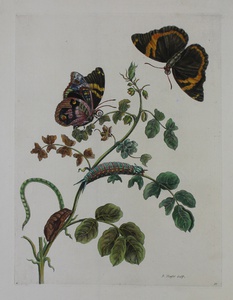| Method | Copper engraving with hand colouring |
| Artist | P. Sluyter after Maria Sibylla Merian |
| Published | [Pierre Gosse, The Hague, 1719] |
| Dimensions | Image 310 x 225 mm, Plate 325 x 250 mm, Sheet 508 x 355 mm |
| Notes |
Plate 32 from Maria Merian's important and influential Metamorphosis Insectorum Surinamensium illustrating a Coffee Senna plant (Senna occidentalis) with the life cycle of a Split-Banded Owlet Butterfly (Opsiphanes cassina merianae). In 1699, Maria and her daughter sailed to Surinam to study the indigenous flora and fauna. Merian was forced to return two years later because of malaria. On her return, Maria and her daughter set about producing her masterpiece Metamorphosis Insectorum Surinamensium. This work was revolutionary in showing the entomology and botany of Suriname. Importantly it also showed the metamorphosis and lifecycles of insects, which up until this point were thought to have come out of spontaneous regeneration. Merian's work was undoubtly scientific, but also incredibly beautiful. Maria Sibylla Merian (2 April 1647-13 January 1717) was the German-born daughter of the Swiss publisher and engraver Matthäus Merian the Elder. Maria became one of the greatest natural history artists of her time. She was fascinated by the life cycles of insects, going on to record over 186 species in her lifetime. Merian was encouraged to study and draw by her artist stepfather Jacob Marrel alongside his pupil Abraham Mignon and later Johann Graff, whom she subsequently married. Maria later went on to teach painting and drawing while producing drawing for embroidery designs. |
| Framing | framed |
| Price | £1,900.00 |
| Stock ID | 50051 |

